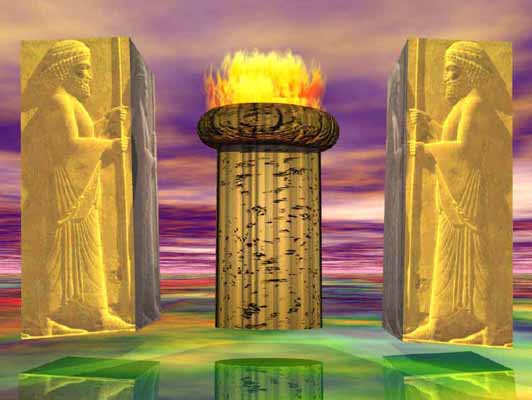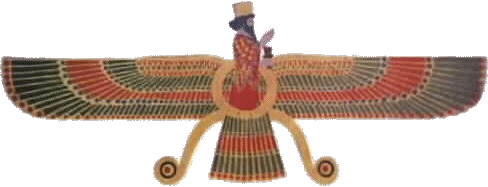|
Zarathrustra, The Persian Prophet
In Old Persian he was called Zarathrustra or Zarthost. In a Greek transliteration he was known as Zoroaster.
A biographical account of Zoroaster is tenuous at best or speculative at the other extreme.
There are many conflicting version as to when Zarathrustra lived. No one knows exactly the dates of his birth and death.
Some research date Zarathrustra's birth to anywhere between 1500 B.C. and 1000 B.C., or even earlier. Most versions date him to approximately 600 BC - also the time line for Buddha. According to tradition, his birth date was 628 BC.
Zarathrustra was supposedly born into a modestly situated family of knights, the Spitama, probably at Rhages (now Rayy, a suburb of Tehran), a town in Media - which is the region covered by modern-day Iran and Iraq. The area in which he lived was not yet urban, its economy being based on animal husbandry and pastoral occupations. Nomads, who frequently raided those engaged in such occupations, were viewed by Zoroaster as aggressive violators of order, and he called them followers of the Lie.
According to the sources Zarathrustra probably was a priest

He supposedly had a vision at age 40 wherein
he received a vision from God - Ahura Mazda -
who appointed him to preach the truth.
Zarathrustra was remember as a religious reformer and founder of Zoroastrianism, or Parsiism, as it is known in India. Like Akhenaten in 18th Dynasty Egypt, Zarathrustra introduced the concept of monotheism in his time line.
Zarathustra built his monotheistic teaching from the religious material of his time. He named the one God "Ahura," the old name for "God" or "Lord," and added to it the new epithet "Mazda," which means "wise." Forever after, the name of God for Zoroastrians (or as they are known in Iran, Zarthustis) would be Ahura Mazda, the "Wise Lord."
The story of the prophet, and his teachings, are contained in a short series of poetic songs known as the Gathas. They are the primary scriptures of Zoroastrianism, and are believed to have actually been composed by Zarathustra. The language of the Gathas is a very difficult and ancient Indo-Iranian language known as Avestan (called Avesta by Zoroastrians), which is closely related to the Sanskrit of the Rig-Veda. It is the comparison of Avestan with Vedic Sanskrit that has given modern scholars a date for Zarathushtra's work which is far earlier than the traditional Zoroastrian date of 600 BCE.
Zoroastrianism also was a strong influence in the more esoteric sects of Judaism, such as the Essenes. There are passages in the Essene documents found in the Dead Sea Scrolls which seem to be directly borrowed from Zoroastrian sources. These texts describe the spirit of truth in conflict with the spirit of error, and a battle of the sons of lightagainst the sons of darkness. This scenario later became part of Christian mythology and cosmic battles of this type appear in many apocalyptic texts such as the Book of Revelation.
According to tradition, Zoroaster lived for 77 years, thus indicating that he died about 551 BC. After his death, many legends arose about him. According to these legends, nature rejoiced at his birth, and he preached to many nations, founded sacred fires, and fought in a sacred war. He was viewed as a model for priests, warriors, and agriculturalists, as well as a skilled craftsman and healer. The Greeks regarded him as a philosopher, mathematician, astrologer, and magician. Jews and Christians regarded him as an astrologer, magician, prophet, or arch heretic.
The mystical side of Zoroaster is what he really was about. The hidden metaphors in his teachings and life follow patterns of other spiritual leaders that brought knowledge to humanity about its origins. It is all about metaphors that help human consciousness come into higher awareness at this time.
. Zarathrustra - Zoroaster - Z is represented by the sacred light / flame.

Zarathrustra is the same soul who played many important roles in Earth's history. He often played these roles simultaneously. Zarathrustra was many of the Pharaohs, including Akhenaten - Moses, Buddha, Jesus, among others. One souls does play all the roles, though I understand that many people think that it was different souls playing each role, in the same way many people believe in the illusion of linear time.
If you understand that concept that the soul does not play one role but returns to play many roles - and is multidimensional in nature - meaning your soul is not just here in your physical body but is experiences in other realms (such as dream time) then you understand that Z came to this reality many times to teach about the nature of creation and reality.
Understanding that third dimension - the physical experience - is created with electromagnetic energy fields - reverse polarities - dualities - (North-South as in magnets - poles - the current talk of pole shifts) - Zarathrustra created the concept of God (Good) and Devil (Evil). He named the Devil Ahriman - also known as Satan, The Trickster, Lucifer.
The Supreme Being was called Ahuramazda. Zarathrustra's conception of him was identical with the Jewish notion of Jehovah. He is referred to as "the Creator of the Earthly and spiritual life, the Lord of the whole universe, at whose hands are all the creatures." He is wisdom and intellect; the light itself, and the source of light; the rewarder of the virtuous and the punisher of the wicked.
Zarathrustra taught the idea of a future life and the immortality of the soul. The doctrine of the resurrection is one of the principal dogmas of the Zendavesta. He also clearly inculcated the belief of a heaven and a hell. The former was called the House of Hymns, because the angels were supposed to sing hymns there; and the latter the House of Destruction, and to it were relentlessly consigned the poets and Priests of the old Aryian religion.
The doctrine of sacred names, so familiar to the Hebrews, was also taught by Zarathrustra. In one of the Yashts, a portion of the Zendavesta, Ahuramazda tells Zarathrustra that the utterance of one of his sacred names, of which he enumerates twenty, is the best protection from evil. Of these names, one is Ahmi, meaning I am, and another, ahmi yat amhi - I am who I am. The Holy Name in Exodus is Ehyeh asher Ehyeh, or I am that I am.
Zarathrustra is linked with the planet, Saturn, the planet that represents challenges through learning lesson.
Zoroaster was the priest/reformer who converted ancient Persian kings to monotheism in 600 B.C. His teachings about heaven and hell, the struggle between good and evil, and the seven archangels influenced the Jews during their Babylonian captivity, and became a part of Judaism. His sacred fire ceremony is still practiced in India by modern Zoroastrians, the Parsi.
As the representative of Saturn on the Planetary Council, Zoroaster is concerned with structure, responsibility, order and destiny. Saturn is the university center of the solar system where souls preparing for incarnation go for instruction.
The Occult and Other Roles of Zoroaster.

Zoroaster was believed to be connected with occult knowledge and magical practices in the Near Eastern and Mediterranean world in the Hellenistic Age (c. 300 BC-c. AD 300).

A Rainbow over the Temple of Zoroaster
Center Circle=Soul
Omega=Leo=Lion,
Circle=Completion

This is the Faravahar or Farohar.
Wings, Layers of Reality
Gold=Alchemy=Transition Metals
Exit through the crown -
The crown chakra.
The Faravahar or Farohar is the spirit of human being that had been existed before his/her birth and will continue to exist after his/her death
According to the Gathas, Ahura Mazda is the creator of heaven and Earth, the material and spiritual worlds. He is the source of the alternation of light and darkness, the Lord of Light, and the very center of nature, as well as the sovereign lawgiver, the originator of the moral order and judge of the entire world.
Ahuramazda is, according to the Gathas, the creator of heaven and Earth, the material and spiritual worlds. He is the source of the alternation of light and darkness, the Lord of Light, and the very centre of nature, as well as the sovereign lawgiver, the originator of the moral order and judge of the entire world. A limited number of six or seven archangels (depending on whether the Holy Spirit is counted or not) were recognized helpers or genii of Ahuramazda as personifications of abstract qualities that the later Avesta calls Amesha Spentas, "glorious immortals." The idea of gods coming in sevens is ancient. In Canaan, there were seven storm gods called Baalim. An Akkadian text has seven Adads and so does an Assyrian text from Assur. In the Sumerian Hymn to Iskur,Ê Enlil gives seven storm winds to Iskur.
Since Mazda was Varuna or Zeus, a sky god, Zoroaster is surely here personifying the colors of the rainbow, variously seen as six or seven. The names of the Amesha Spentas frequently recur throughout the Gathas and characterize Zoroaster's thought and his concept of god.
Zoroaster saw two primeval spirits as twins in opposition. Ahuramazda was Spenta Mainyu and the other spirit was Angra Mainyu, who is the original Satan and the reason why righteous people suffered. But Spenta Mainyu elsewhere seems to exist independently. The Holy Spirit of the Jewish god is just the same, and then the Christians extended the concept to the Son, who is the Father, but acts independently. The son of Ahuramazda was Mithras.
The Fate of the Soul
Zoroastrian view - The dead soul journeyed to the bridge to heaven where the book was opened. The honest and the deceitful have both to be assessed at the account-keeper's bridge where their deeds are measured. The account-keeper's bridge has many paths across, some being broad and some as narrow as a razor's edge. The truthful souls take the broad routes and the lying souls have to try to balance their way across on the narrow routes. The truthful are therefore able to cross into heaven easily but the false find it impossible to cross and fall into the Abyss. The concept of the bridge will be based on the rainbow, seen as a bridge to heaven, and appears in Islam as the Arch of Al-Sirat.
Neither good nor evil would be victorious but eventually Ahriman would be defeated by a Deliverer sent by god, the Saoshyant. The Saoshyant, of the line of Zoroaster or perhaps the prophet himself reincarnated, would herald the beginning of a new age.
|
